Bidirectional-Reinforced Carbon Fiber/Polyether-Ether-Ketone Composite Thin-Walled Pipes via Pultrusion-Winding for On-Orbit Additive Manufacturing
Abstract
:1. Introduction
2. Materials and Methods
2.1. Materials
2.2. Preparation of CF/PEEK Pipes
2.3. Design of Different Pipe Fitting Samples
2.4. Characterization
2.5. Finite Element Simulation Analysis
3. Results and Discussion
3.1. Optimization of Fabrication Parameters
3.2. Effect of Axial Layer Number on Mechanical Properties of CF/PEEK Pipes
3.3. Effect of Pultrusion–Winding Cycles on Mechanical Properties of CF/PEEK Pipes
3.4. Analysis of Compression Failure Forms of Pipes
4. Conclusions
- This approach not only achieved bidirectional enhancement of pipes, but also breaks through the size limitation of core mold.
- The parameters including pultrusion temperature, winding speed, winding pressure, and winding angle were optimized, which provided basic experimental data for practical applications.
- The mechanical properties of the pipes including axial compressive strength, circumferential compressive stiffness, and interlayer shear strength were tested for pipes with different axial layers numbers and winding times. It was found that the axial compressive strength could be greatly increased due to the increase in axial prepreg tape layer.
- The interlayer shear strength can be effectively improved due to the increase in pultrusion–winding cycles. The finite element simulation results also proved that the axial fibers share the most axial stress while the circumferential layer greatly decreases the shear strain.
Author Contributions
Funding
Institutional Review Board Statement
Informed Consent Statement
Data Availability Statement
Conflicts of Interest
References
- Bourseau, F.; Grugeon, S.; Lafont, U.; Dupont, L. 3D printing of solid polymer electrolytes by fused filament fabrication: Challenges towards in-space manufacturing. J. Phys.-Energy 2024, 6, 012001. [Google Scholar] [CrossRef]
- Makaya, A.; Pambaguian, L.; Ghidini, T.; Rohr, T.; Lafont, U.; Meurisse, A. Towards out of earth manufacturing: Overview of the ESA materials and processes activities on manufacturing in space. CEAS Space J. 2023, 15, 69–75. [Google Scholar] [CrossRef]
- Prater, T.; Werkheiser, N.; Ledbetter, F.; Timucin, D.; Wheeler, K.; Snyder, M. 3D Printing in Zero G Technology Demonstration Mission: Complete experimental results and summary of related material modeling efforts. Int. J. Adv. Manuf. Tech. 2019, 101, 391–417. [Google Scholar] [CrossRef] [PubMed]
- Prater, T.; Bean, Q.; Werkheiser, N.; Grguel, R.; Beshears, R.; Rolin, T.; Huff, T.; Ryan, R.; Ledbetter, F.; Ordonez, E. Analysis of specimens from phase I of the 3D printing in Zero G technology demonstration mission. Rapid Prototyp. J. 2017, 23, 1212–1225. [Google Scholar] [CrossRef]
- Datashvili, L.; Endler, S.; Wei, B.; Baier, H.; Langer, H.; Friemel, M.; Tsignadze, N.; Santiago-Prowald, J. Study of mechanical architectures of large deployable space antenna apertures: From design to tests. CEAS Space J. 2013, 5, 169–184. [Google Scholar] [CrossRef]
- De Zanet, G.; Viquerat, A.; Aglietti, G. Predicted thermal response of a deployable high-strain composite telescope in low-Earth orbit. Acta Astronaut. 2023, 205, 127–143. [Google Scholar] [CrossRef]
- Cheng, Z.; Hou, X.; Zhang, X.; Zhou, L.; Guo, J.; Song, C. In-orbit assembly mission for the Space Solar Power Station. Acta Astronaut. 2016, 129, 299–308. [Google Scholar] [CrossRef]
- Benaroya, H.; Bernold, L.; Chua, K.M. Engineering, design and construction of lunar bases. J. Aerospace Eng. 2002, 15, 33–45. [Google Scholar] [CrossRef]
- Carignan, C.R.; Detry, R.; Saaj, M.C.; Marani, G.; Vander Hook, J.D. Robotic in-situ servicing, assembly and manufacturing. Front. Robot. AI 2022, 9, 887506. [Google Scholar] [CrossRef]
- Shi, J.; Mizuno, M.; Bao, L.; Zhu, C. A Facile Molding Method of Continuous Fiber-Reinforced Thermoplastic Composites and Its Mechanical Property. Polymers 2022, 14, 947. [Google Scholar] [CrossRef]
- Troschitz, J.; Gröger, B.; Würfel, V.; Kupfer, R.; Gude, M. Joining Processes for Fibre-Reinforced Thermoplastics: Phenomena and Characterisation. Materials 2022, 15, 5454. [Google Scholar] [CrossRef] [PubMed]
- Chen, H.; Li, S.; Wang, J.; Ding, A. A focused review on the thermo-stamping process and simulation progresses of continuous fibre reinforced thermoplastic composites. Compos. Part B-Eng. 2021, 224, 109196. [Google Scholar] [CrossRef]
- Campos, D.; Maimí, P.; Martín, A. Statistical Study of the Process Parameters for Achieving Continuous Consolidation of a Thermoplastic Composite. Materials 2023, 16, 6723. [Google Scholar] [CrossRef] [PubMed]
- Obande, W.; Bradaigh, C.M.O.; Ray, D. Continuous fibre-reinforced thermoplastic acrylic-matrix composites prepared by liquid resin infusion-A review. Compos. Part B-Eng. 2021, 215, 108771. [Google Scholar] [CrossRef]
- Chen, Y.; Shan, Z.; Yang, X.; Fan, C.; Song, Y. Influence of preheating temperature and printing speed on interlaminar shear performance of laser-assisted additive manufacturing for CCF/PEEK composites. Polym. Compos. 2022, 43, 3412–3425. [Google Scholar] [CrossRef]
- Luo, M.; Tian, X.; Shang, J.; Yun, J.; Zhu, W.; Li, D.; Qin, Y. Bi-scale interfacial bond behaviors of CCF/PEEK composites by plasma-laser cooperatively assisted 3D printing process. Compos. Part A Appl. Sci. Manuf. 2020, 131, 105812. [Google Scholar] [CrossRef]
- Zhao, Z.; Zhang, J.; Bi, R.; Chen, C.; Yao, J.; Liu, G. Study on the Overmolding Process of Carbon-Fiber-Reinforced Poly (Aryl Ether Ketone) (PAEK)/Poly (Ether Ether Ketone) (PEEK) Thermoplastic Composites. Materials 2023, 16, 4456. [Google Scholar] [CrossRef]
- Choi, B.-K.; Kang, C.-S.; Yoo, M.-H.; Seo, M.-K. Effect of Processing Parameters on Bonding Performance of a Carbon Fiber/Polyetheretherketone Thermoplastic Composite Prepared by Induction Welding. Materials 2023, 16, 3954. [Google Scholar] [CrossRef]
- Boon, Y.D.; Joshi, S.C.; Bhudolia, S.K. Filament winding and automated fiber placement with in situ consolidation for fiber reinforced thermoplastic polymer composites. Polymers 2021, 13, 1951. [Google Scholar] [CrossRef]
- Liou, Y.-S.; Luo, S.-Y. Fabrication of bilayer resin-bonded fixed abrasive wires using the pultrusion process. J. Polym. Eng. 2018, 38, 187–195. [Google Scholar] [CrossRef]
- Hosseini, S.M.A.; Baran, I.; van Drongelen, M.; Akkerman, R. On the temperature evolution during continuous laser-assisted tape winding of multiple C/PEEK layers: The effect of roller deformation. Int. J. Mater. Form. 2021, 14, 203–221. [Google Scholar] [CrossRef]
- Chen, K.; Jia, M.; Sun, H.; Xue, P. Thermoplastic Reaction Injection Pultrusion for Continuous Glass Fiber-Reinforced Polyamide-6 Composites. Materials 2019, 12, 463. [Google Scholar] [CrossRef] [PubMed]
- Paek, S.W.; Balasubramanian, S.; Stupples, D. Composites Additive Manufacturing for Space Applications: A Review. Materials 2022, 15, 4709. [Google Scholar] [CrossRef] [PubMed]
- McNiffe, E.; Ritter, T.; Higgins, T.; Sam-Daliri, O.; Flanagan, T.; Walls, M.; Ghabezi, P.; Finnegan, W.; Mitchell, S.; Harrison, N.M. Advancements in functionally graded polyether ether ketone components: Design, manufacturing, and characterisation using a modified 3D printer. Polymers 2023, 15, 2992. [Google Scholar] [CrossRef]
- Santiago, C.C.; Yelamanchi, B.; Diosdado De la Peña, J.A.; Lamb, J.; Roguski, K.; Turzyński, F.; Faruqui, R.; Choo, K.; Du Plessis, A.; Sillani, F. Thermoplastic extrusion additive manufacturing of high-performance carbon fiber PEEK lattices. Crystals 2021, 11, 1453. [Google Scholar] [CrossRef]
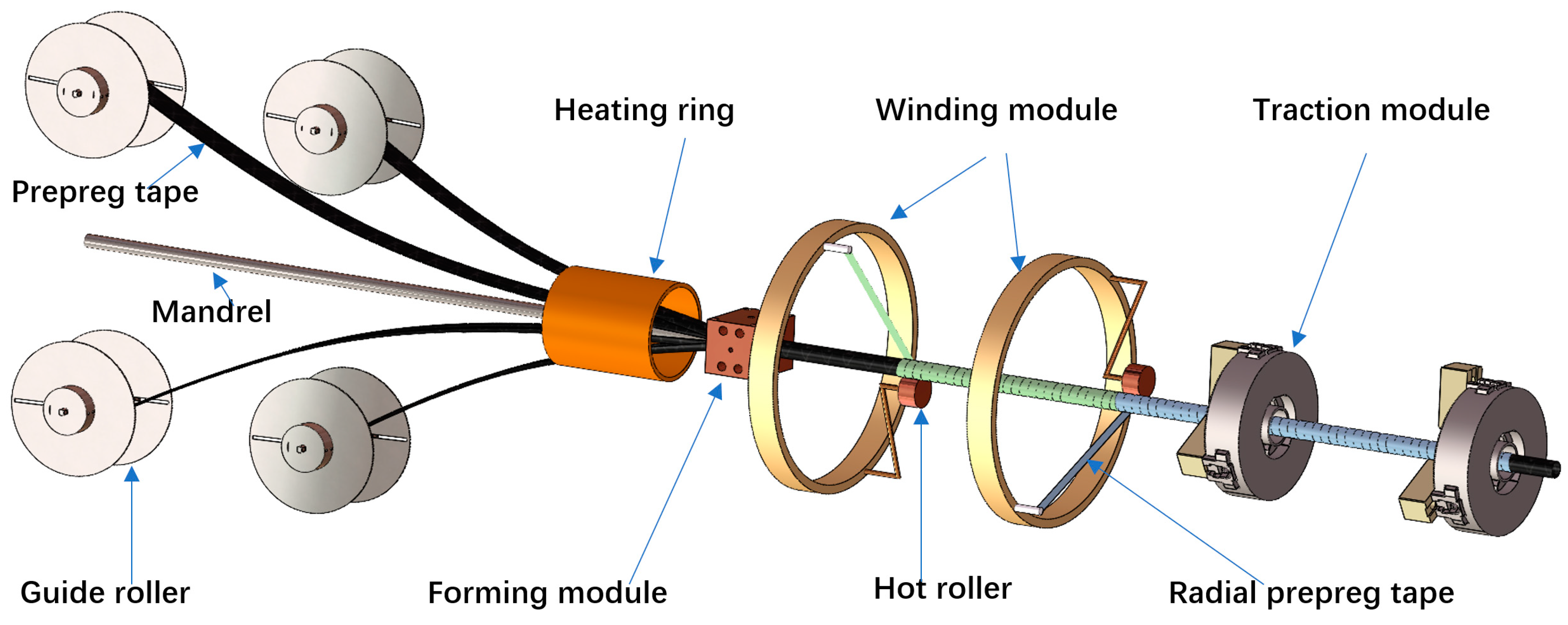

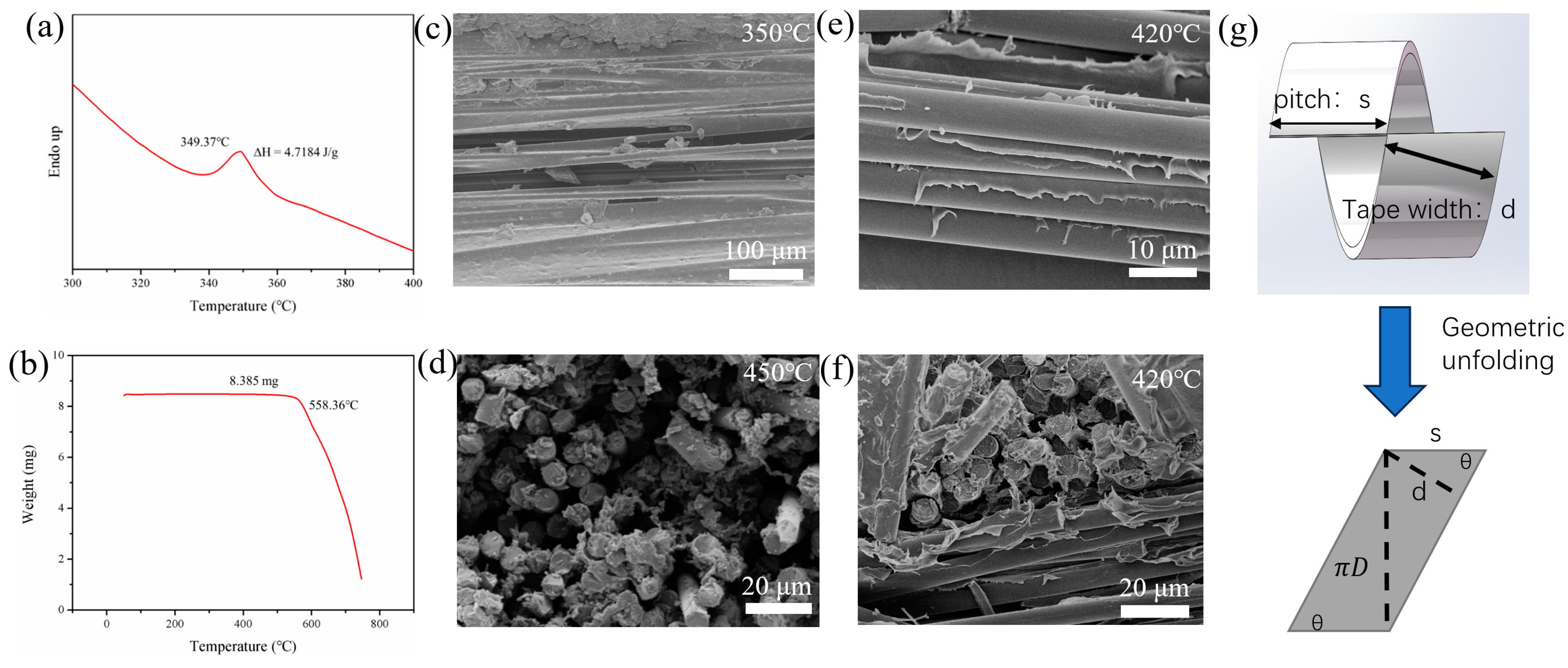
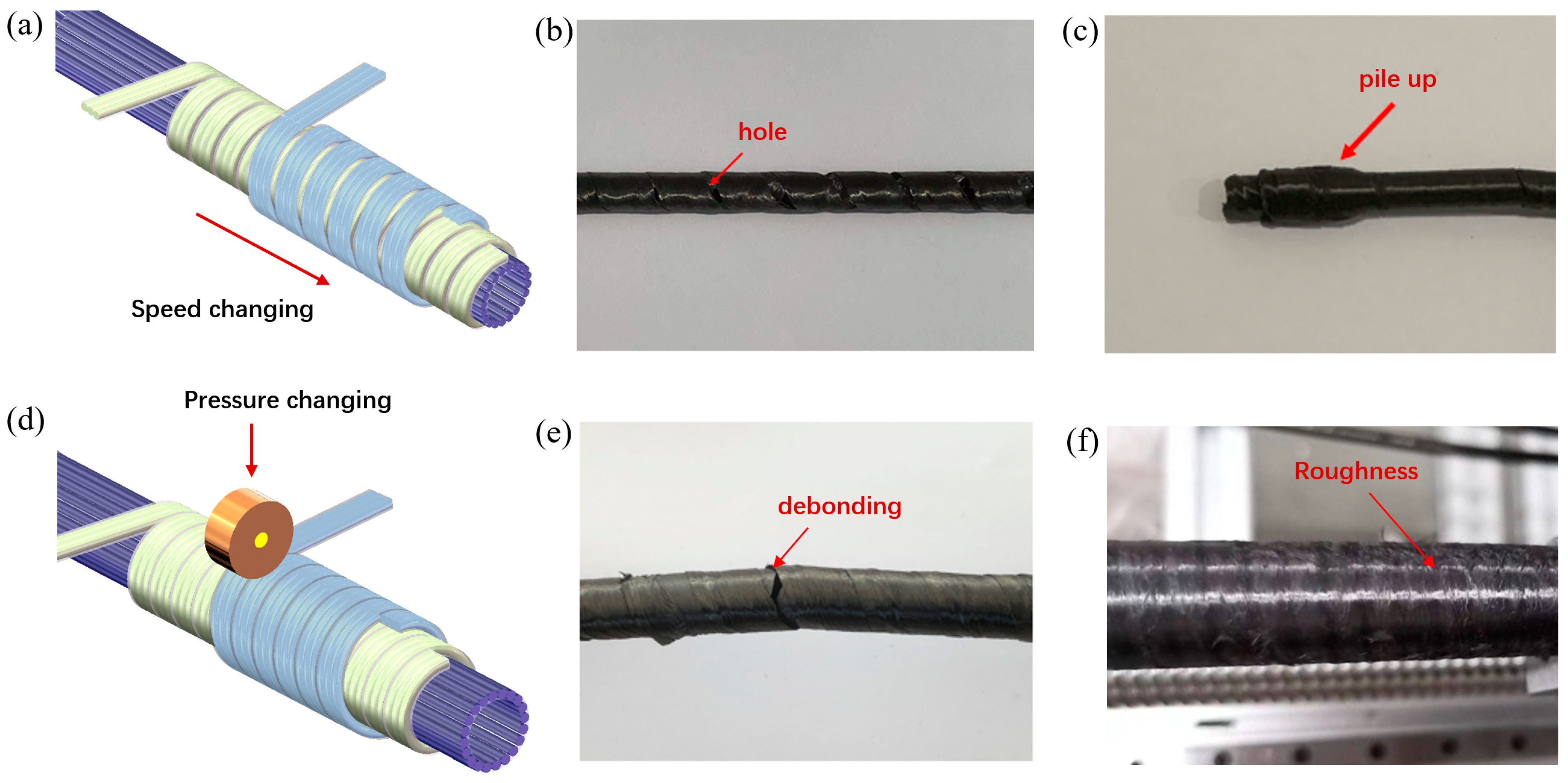


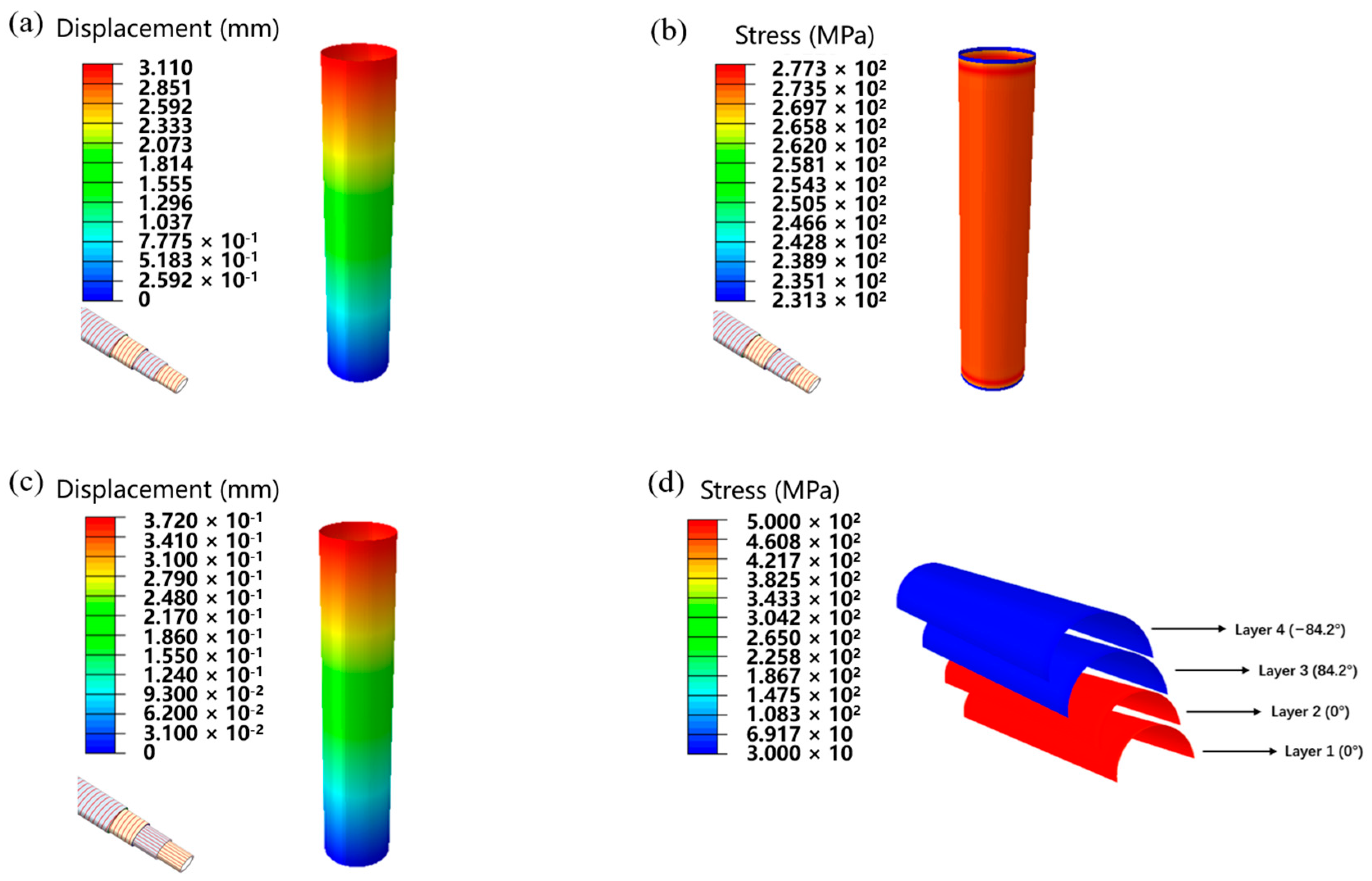
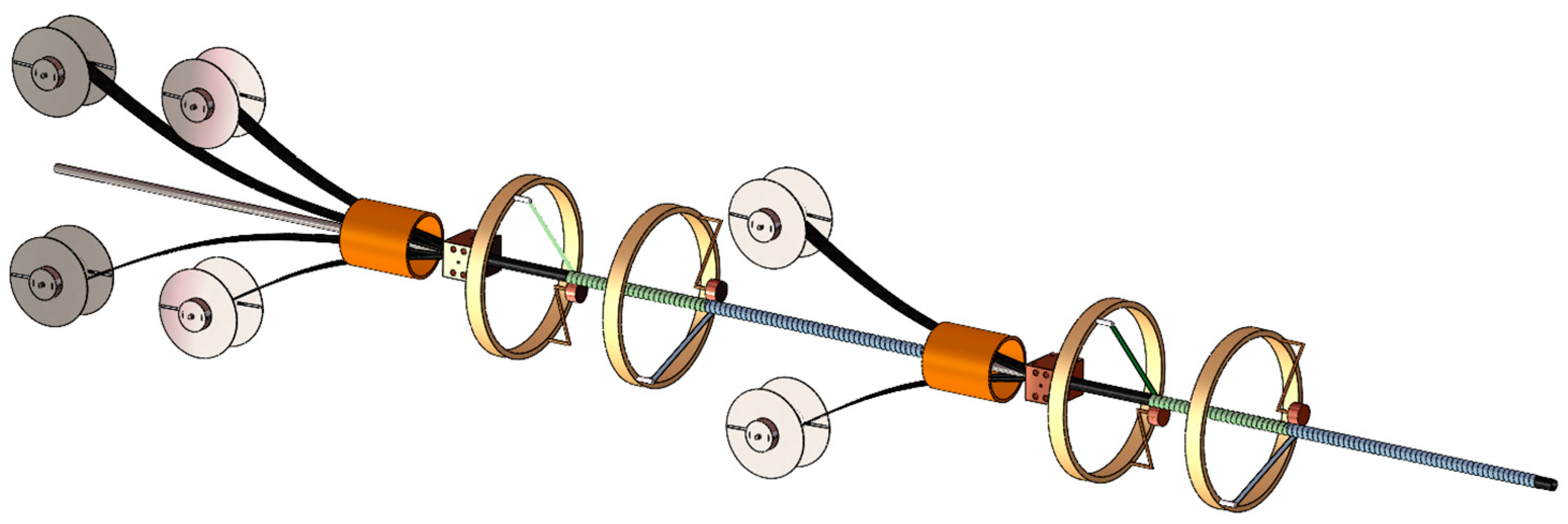
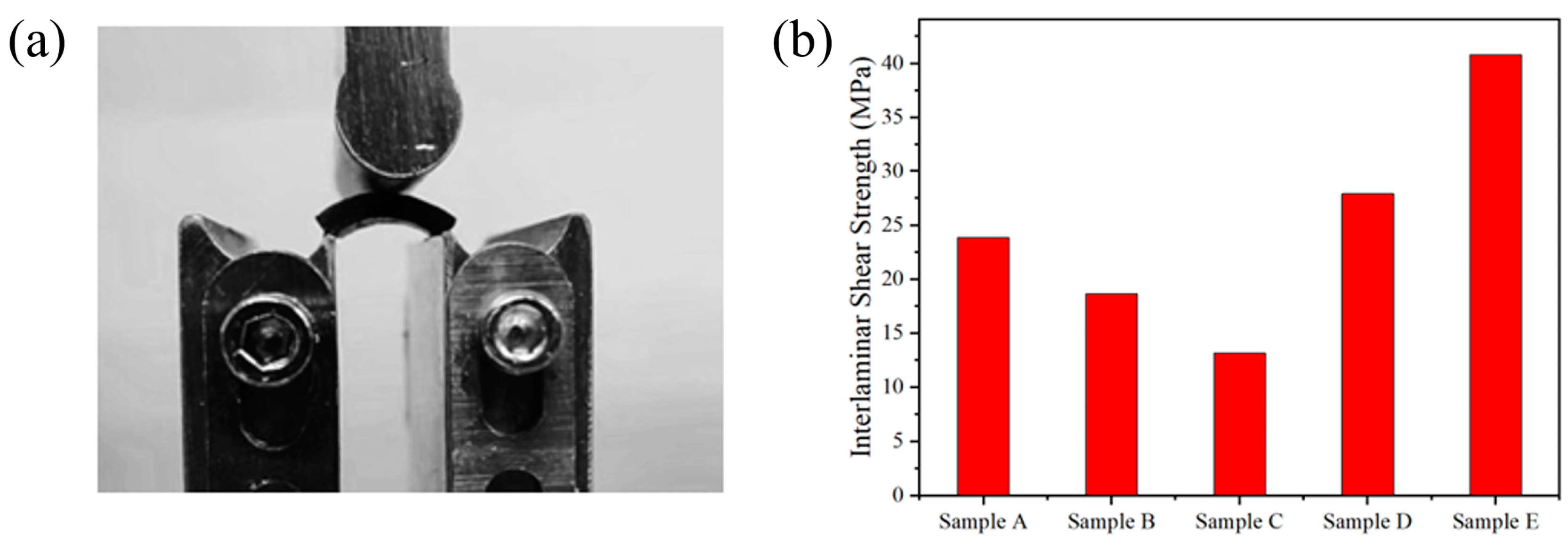



| Type of Pipes | Pipe Layer Design | Wall Thickness (mm) |
|---|---|---|
| Sample A | [02/84.2/−84.2] | 0.61 |
| Sample B | [03/84.2/−84.2] | 0.77 |
| Sample C | [04/84.2/−84.2] | 0.92 |
| Sample D | [0/84.2/−84.2]2 | 0.91 |
| Sample E | [0/84.2/−84.2]4 | 1.81 |
| Material Properties | Input Parameters |
|---|---|
| E1 | 133,000 MPa |
| E2 | 9000 MPa |
| Nu12 | 0.28 |
| G12 | 5100 MPa |
| G13 | 5100 MPa |
| G23 | 3476 MPa |
Disclaimer/Publisher’s Note: The statements, opinions and data contained in all publications are solely those of the individual author(s) and contributor(s) and not of MDPI and/or the editor(s). MDPI and/or the editor(s) disclaim responsibility for any injury to people or property resulting from any ideas, methods, instructions or products referred to in the content. |
© 2024 by the authors. Licensee MDPI, Basel, Switzerland. This article is an open access article distributed under the terms and conditions of the Creative Commons Attribution (CC BY) license (https://creativecommons.org/licenses/by/4.0/).
Share and Cite
Xia, Y.; Jiang, L.; Chen, Y.; Zhao, Y.; Yang, L.; Ge, D. Bidirectional-Reinforced Carbon Fiber/Polyether-Ether-Ketone Composite Thin-Walled Pipes via Pultrusion-Winding for On-Orbit Additive Manufacturing. Materials 2024, 17, 293. https://doi.org/10.3390/ma17020293
Xia Y, Jiang L, Chen Y, Zhao Y, Yang L, Ge D. Bidirectional-Reinforced Carbon Fiber/Polyether-Ether-Ketone Composite Thin-Walled Pipes via Pultrusion-Winding for On-Orbit Additive Manufacturing. Materials. 2024; 17(2):293. https://doi.org/10.3390/ma17020293
Chicago/Turabian StyleXia, Yuanhao, Long Jiang, Yi Chen, Yiping Zhao, Lili Yang, and Dengteng Ge. 2024. "Bidirectional-Reinforced Carbon Fiber/Polyether-Ether-Ketone Composite Thin-Walled Pipes via Pultrusion-Winding for On-Orbit Additive Manufacturing" Materials 17, no. 2: 293. https://doi.org/10.3390/ma17020293





